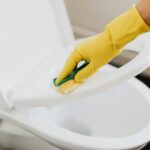If you find sewage coming up from your shower drain, it’s crucial to act quickly. Start by assessing the situation—check for rising water and unpleasant odors. Turning off your main water supply can prevent further flooding and damage. With the area cleared, you might consider using a plunger. But what if that doesn’t work? There are steps you can take to tackle the problem effectively and avoid bigger issues down the line.
Assess the Situation
What do you do when you notice sewage rising from your shower drain? First, stay calm and assess the situation. Check if the water’s still rising or if it’s stabilized. If it’s not overflowing, you’ve got a moment to think.
Next, look for signs of blockage or backups in other drains; this could indicate a bigger problem. You’ll want to smell for any foul odors—if it’s strong, it might be a sewer line issue.
Keep an eye on your bathroom surroundings; any water pooling or leaks can worsen the situation. Finally, take note of any recent plumbing work or heavy rains that might’ve contributed to the problem.
Gathering this information will help you tackle the next steps effectively.
Turn Off Water Supply
Once you’ve assessed the situation and determined that sewage is indeed rising from your shower drain, the next step is to turn off the water supply.
Locate the main water valve, usually found near your water meter or where the water line enters your home. Turn the valve clockwise to cut off the water flow. If you can’t find the main valve, check for localized valves under sinks or behind your toilet.
Turning off the water supply prevents further flooding and minimizes sewage damage. You should also avoid using any other faucets or appliances during this time.
Once the water’s off, you can focus on addressing the sewage issue without adding to the problem. Stay calm; you’re taking the right steps!
Clear the Area
As you prepare to tackle the sewage issue, clearing the area around your shower drain is essential.
Start by removing any items that might be in the way, like bath mats, towels, or toiletries. This not only helps you work more efficiently but also keeps your belongings safe from contamination.
Next, ensure the floor is dry to prevent slipping, which can be hazardous during this process. If your shower door is in the way, consider temporarily removing it for easier access.
Lastly, open windows or turn on fans to improve ventilation; you’ll want to minimize unpleasant odors.
Use a Plunger
When faced with sewage backing up from your shower drain, using a plunger can be an effective first step in addressing the problem.
Start by ensuring there’s enough water in the shower to cover the plunger’s suction cup. Position the plunger over the drain, creating a tight seal, and pump it vigorously up and down.
You’ll want to maintain the seal to create suction and pressure that can dislodge any blockages. After about 15-20 seconds of plunging, lift the plunger to see if the water starts to drain.
If it does, you’ve likely cleared the clog. If not, you might need to try again or consider other methods.
Remember to wear gloves and stay cautious during this messy task.
Try a Drain Snake
Grab a drain snake and tackle that stubborn clog head-on. This handy tool can make a world of difference when sewage backs up into your shower.
Start by inserting the snake into the drain, twisting and pushing gently until you encounter resistance. That’s likely the clog! Keep turning the handle to break through the blockage.
Once you feel it loosen, pull the snake out carefully. You might see hair, soap scum, or other debris attached to it; don’t be surprised!
After you’ve removed the clog, run hot water down the drain to flush away any remaining residue.
With a little effort, you can restore your shower’s drainage and keep sewage from returning. Happy unclogging!
Check for Blockages
Before diving into more complex solutions, it’s crucial to check for blockages in your shower drain.
Start by removing the drain cover, which often collects hair, soap residue, and other debris. Use your hands or a pair of gloves to clear out any visible buildup.
If you can’t see any obstructions but still have issues, try pouring hot water down the drain—this can help dissolve minor clogs. You might also want to use a plunger, ensuring you create a proper seal around the drain.
Call a Professional Plumber
If you’ve checked for blockages and still see sewage backing up from your shower drain, it’s time to call a professional plumber.
Attempting to fix this issue on your own can lead to further complications, including potential damage to your plumbing system. A plumber has the expertise and specialized tools to diagnose the root cause of the problem effectively.
They can address issues like tree root intrusion or major pipe damage that you mightn’t be able to see. Plus, hiring a professional saves you time and stress, ensuring the job gets done right the first time.
Don’t hesitate—sewage backups can lead to health hazards, so reach out to a plumber immediately for a thorough inspection and resolution.
Prevent Future Issues
To keep sewage from backing up into your shower drain in the future, it’s essential to adopt a few proactive habits.
First, install a drain cover to catch hair and debris before they enter the pipes. Regularly clean this cover to ensure it functions effectively.
Next, avoid flushing anything other than toilet paper down the toilet; even small items can lead to blockages.
You should also schedule routine drain cleanings, either through a professional or by using DIY methods like baking soda and vinegar.
Additionally, monitor your plumbing for any signs of wear or leaks.
Clean and Disinfect the Area
Once you’ve addressed the sewage backup, it’s crucial to clean and disinfect the affected area to prevent health risks and lingering odors.
Start by wearing gloves and a mask to protect yourself from harmful bacteria. Use a wet/dry vacuum to remove any remaining water and debris.
Next, scrub surfaces with a mixture of water and a strong disinfectant, ensuring you cover all areas where sewage may have touched. Pay special attention to corners and crevices.
After scrubbing, rinse thoroughly with clean water. Finally, dry the area completely to inhibit mold growth.
Ventilate the space by opening windows or using fans. This thorough cleaning not only safeguards your health but also restores your home’s hygiene and comfort.
Conclusion
Dealing with sewage backing up from your shower drain can be stressful, but acting quickly can make a big difference. By assessing the situation, shutting off the water, and trying some basic tools like a plunger or drain snake, you can often resolve the issue. If those steps don’t work, don’t hesitate to call a professional plumber. Remember, regular maintenance and being cautious about what goes down your drain can help prevent future problems. Stay proactive!


